|
A Rare Rosewood Tea chest with
twin cut crystal tea canisters and central Bowl Circa 1815.
Please click on images to enlarge
Reference: TC 101
Description:
A rosewood veneered tea
chest of superior quality, bound with boxwood. featuring early
Regency decoration and shape.
The chest is fitted with heavy crystal
canisters flanking a crystal bowl.
Origin: United Kingdom
and Ireland.
Circa: 1815
Materials: rosewood
brass and cut crystal.
It measures 12.6 inches
wide, 6.3 inches deep and 7.9 inches high: 32cm wide, 16cm
deep and 20cm high.
These pages are best looked at in full screen. you can toggle full
screen with F11
|

The feet and handles are of
strong neoclassical form. The back is lined in velvet, punctuated with silk
tufts. This interior with cut crystal, which was very costly at the
time, is rare.
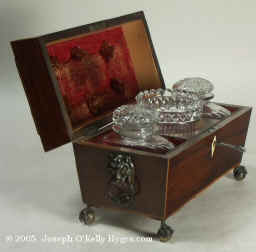
Condition: overall very good
original condition. there is a small chip to one of the canisters, see below. one of the feet appears
to have a replacement ball. one of the claws is missing on one foot.
|
There are lots of photos they can be
seen in higher resolution by clicking on them. They can be viewed as a slide
show in higher resolution.
Please click on images to enlarge
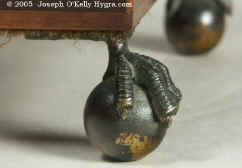
|
The caddy has wonderful claw
and ball feet.
|
Please click on images to enlarge
The handles are
original and made in pressed brass in the form of an Egyptian inspired
leopard. This is a rare form. These are nicely patented and
have traces of their gilding.
They are very similar to the
handles on another chest of the same date: www.hygra.com/o/brchtc.htm
|
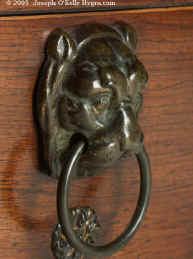
|

|
Egyptian inspired leopard
handles.
|
Please click on images to enlarge
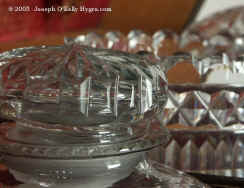
|
The opulence of
having twin cut crystal canisters.
|
Please click on images to enlarge
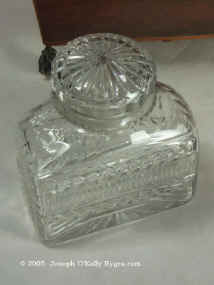
|
The stoppers of the canisters
are also hand-blown. They have a star cut to their tops.
|
Superficially
the canisters look the same. They are hand blown and then cut freehand.
The squared
shape is achieved by blowing into at heated form mold.
The stoppers are not interchangeable. There are also slight differences to
the faceting.
The neck of one
is at a slight angle.
|

The Canisters
are probably Irish. The tax on the weight of materials used in glass
manufacturing in England and Scotland did not apply in Ireland until
1825.
This resulted in the setting up of glassworks in various port
towns in Ireland such as Waterford and Cork (1783). See: Irish
Crystal
by Pat Friend
|
Please click on images to enlarge
Please click on images to enlarge
The top is lined with its
original tufted velvet. Both the bowl well and the compartments for the
canisters are lined with fine red leather.
|
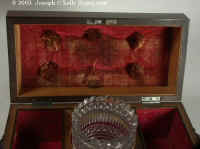
|
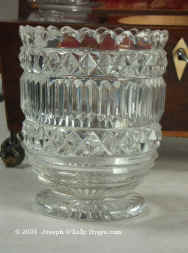
|
The exquisite
bowl.
This is serious hand blown and
hand cut glass.
There are little differences in
the faceting. Each was looked at as it was cut by the original artist who
is now un-named.
|
Please click on images to enlarge
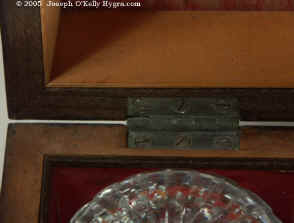
|
The hinges look undisturbed .
The screws all look original
|
Please click on images to enlarge
Please click on images to enlarge
| The lock works. The
key is a modern replacement. |

|
Please click on images to enlarge
The rosewood is edged
with boxwood. The tapering sides and the cavetto molding are of
classical inspiration. The pyramided top is framed by a cavetto molding.
|
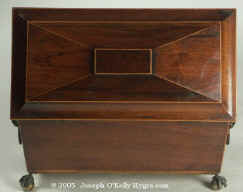
|
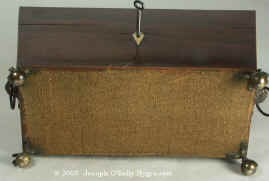
|
The cloth on the underside
looks original.
|
Please click on images to enlarge
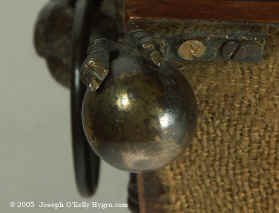
|
Some of the screws
holding the feet look newer.
|
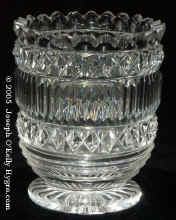
|
There are little differences
in the faceting. Each was looked at as it was cut by the original artist
who is now un-named.
|
Please click on images to enlarge
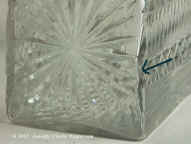
|
There is a slight chip to the
right edge m of one of the canisters. see arrow.
|
I do not know if this glass is Cork
or Waterford. It is one or the other. I was told simple ways of telling, like
the hobnail (pyramid) cut is smaller, which I am no longer convinced by.
Workers moved between factories. The extent to which the factory dictated
style, or the artists conformed with the style is a little written
story.
The glass tells the story.
All text and images and linked images are ©
1999-2004 Antigone Clarke and Joseph O'Kelly. If you require any further
information on permitted use, or a licence to republish any material, email us
at copyright@hygra.com
| 